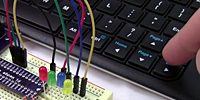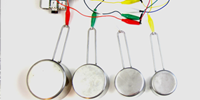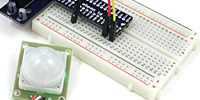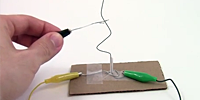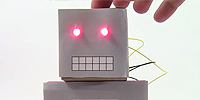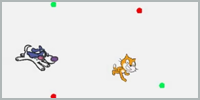Getting Started with your Raspberry Pi Projects Kit
Welcome
Congratulations on the purchase of your Science Buddies Raspberry Pi Projects Kit or Circuit Building Kit for Raspberry Pi! After completing your kit setup, you can use our online, step-by-step instructions to complete these 8 projects:
Setup
This video will guide you through the steps to get your Raspberry Pi 3B+ up and running. Written instructions are also available below the video. (If you are using a different model Raspberry Pi, you will need to modify the setup instructions accordingly—consult theRaspberry Pi Foundation's Setting up your Raspberry Pi page for assistance.)
In addition to the contents of your kit, you will also need:
- A TV or computer monitor with an HDMI input
- Headphones or external speakers (only needed if your TV or monitor does not have built-in speakers)
- A USB keyboard and mouse
If your TV or monitor does not have an HDMI input, please refer to our setup FAQ.
Refer to Figures 1 and 2 as you connect your Raspberry Pi 3B+.
- Your kit comes with a clear plastic case to help protect your Raspberry Pi. Snap the Raspberry Pi into the bottom half of the case, then snap on the top half of the case.
- Insert the SD card into the slot on the underside of your Raspberry Pi.
- Plug in your USB keyboard and mouse.
- Plug the HDMI cable into the HDMI port. Connect the other end to your TV or computer monitor.
- If you are using external speakers or headphones, plug them into the headphone jack.
- The T-shaped red part in your kit is called the Pi Wedge. It will allow you to connect your Raspberry Pi to a breadboard, which you can use to build electrical circuits. The Pi Wedge is connected to the Raspberry Pi's GPIO header by a gray ribbon cable.
- Plug one end of the ribbon cable into the Pi Wedge. The black plastic pieces on each end of the ribbon cable are notched, so they can only fit into the Pi Wedge in one direction.
- Carefully plug the other end of the ribbon cable into the Raspberry Pi's GPIO header. Do not force it or push at an angle, or you might bend the pins.
- Plug the Pi Wedge into the breadboard. The first two pins on the Pi Wedge (labeled G17 and G18) should go into Row 1 of the breadboard.
- Plug your USB power supply into a wall outlet, and plug the other end into the Raspberry Pi's micro-USB port. Important: make sure you plug in the power cable last. If you plug in the power cable before you plug in the other peripherals, your Raspberry Pi may not boot up properly.
- Once your Raspberry Pi has booted up, double-click on the "SB" icon on the desktop and choose the first project you want to work on.
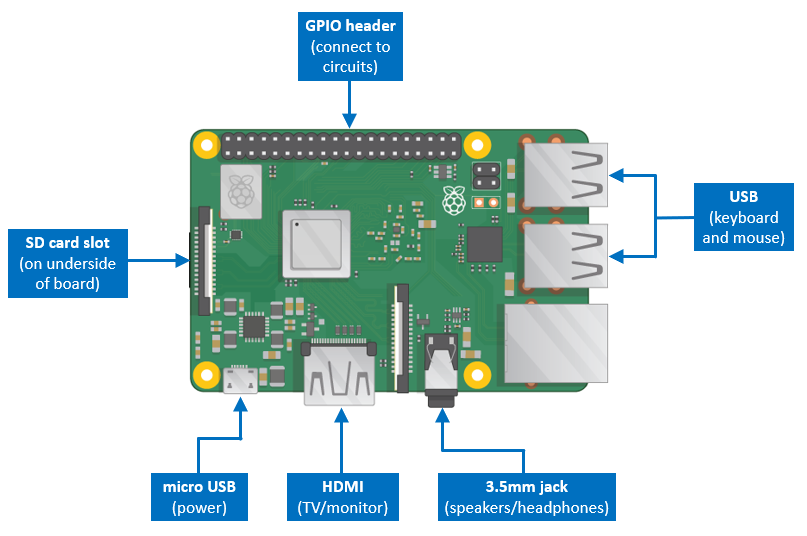
Figure 1. Raspberry Pi connections. (Raspberry Pi graphic credit the Raspberry Pi Foundation, under Creative Commons Attribution-ShareAlike 4.0 International License)
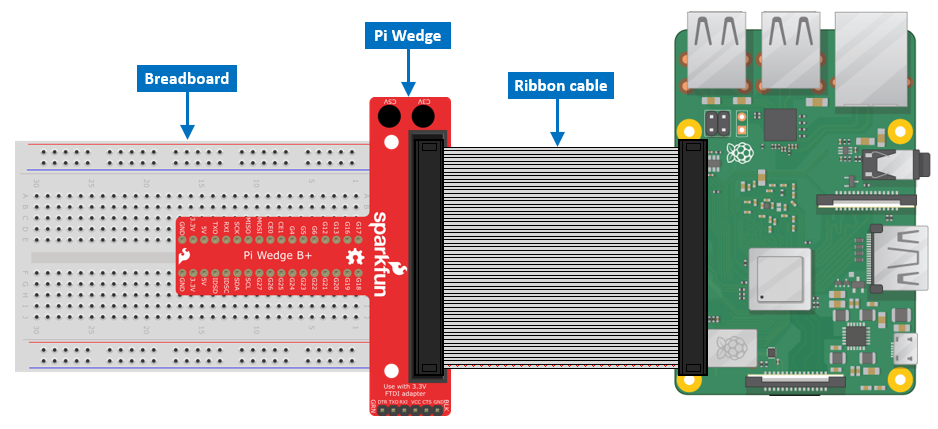
Figure 2. Raspberry Pi connection to breadboard. (Raspberry Pi graphic credit the Raspberry Pi Foundation, under Creative Commons Attribution-ShareAlike 4.0 International License. Pi Wedge graphic from Fritzing.)
Need Help?
Do you need help or have questions about using your Raspberry Pi Projects Kit or Circuit Building Kit for Raspberry Pi? Our list of Frequently Asked Questions is the place to start. You may find we have just the answer you need!
Kit General Questions
- Who is the kit appropriate for?
- Are the kit parts reusable?
- Aren't there other Raspberry Pi kits on the market? How is yours different?
- I already have a Raspberry Pi. Can I just buy the circuit parts separately?
- What programming language do the projects use?
Setting Up and Using Your Raspberry Pi FAQ
- How do I connect my Raspberry Pi to my TV or computer monitor?
- Can I use a laptop as a display and/or keyboard?
- How do I connect my Raspberry Pi to the internet?
- How do I shut down or reboot my Raspberry Pi? There's no power button!
- How can I adjust the Raspberry Pi's display resolution?
- I have everything connected properly, why can't I hear any sound?
- Why won't my Raspberry Pi turn on?
- My Raspberry Pi starts to boot up, but then it freezes or the screen goes blank. What is wrong?
- My Raspberry Pi froze and is not responding to mouse or keyboard input. What should I do?
- My Raspberry Pi is acting strangely (it suddenly will not boot up properly, certain programs do not work, etcetera). What is wrong?
- I think I corrupted my Raspberry Pi's SD card. What should I do?
- I need help with a question, related to my Science Buddies Raspberry Pi Projects Kit or Raspberry Pi Circuits Parts Only Kit, not listed here. Who can I ask?
Kit General Answers
Q: Who is the kit appropriate for?A: The kit is meant for anyone (ages 8 and up) who wants to learn some basic programming and electronics skills while having fun. Students up to age 10, or older if their reading skills are behind grade level, may need adult assistance in reading and following the on-screen instructions. The projects included in the kit were beta tested and approved by students ages 8 to 16.
Q: Are the kit parts reusable?
A: Yes, all the electronics components in the kit can be re-used to do new projects or to repeat the projects.
Q: Aren't there other Raspberry Pi kits on the market? How is yours different?
A: Yes, there are other Raspberry Pi kits, and some of them are quite good! The Raspberry Pi Projects Kit and Raspberry Pi Circuit Parts Only Kit have been designed to contain the specific materials needed to do the accompanying Science Buddies Raspberry Pi projects. Our kit and associated projects are specifically meant for people who have no prior experience programming or connecting circuits. The projects are 100% beginner friendly with clear on-screen instructions, pictures, and videos. We think the kit, with its associated projects, is one of the most fun kits out there! But, if you are already an ace programmer or electronics guru, you may not find this the best fit for your own personal use. Even so, it may be a fun way for you to introduce others to programming and electronics.
Q: I already have a Raspberry Pi. Can I just buy the circuit parts separately?
A: Yes! We sell two different kits: the Raspberry Pi Projects Kit which includes a Raspberry Pi and the required accessories, and the Raspberry Pi Circuit Parts Only Kit, which only contains the additional circuit parts you need to do the Science Buddies projects. Both kits contain an SD card with the Raspbian operating system and a desktop shortcut to the Science Buddies project instructions.
Q: What programming language do the projects use?
A: The projects use Scratch 2. Scratch is a "graphical" programming language developed by the MIT Media Lab. It allows you to write code by clicking, dragging, and snapping together color-coded blocks. This allows beginners to write working code without worrying about formatting or typos. On the Raspberry Pi, Scratch allows you to control the general purpose input and output (GPIO) pins so your program can interact with a circuit in the physical world.
Note: three different versions of Scratch (1, 2, and 3) are available for the Raspberry Pi. The instructions for the Science Buddies projects (including example code) are specifically written for Scratch 2, which runs well on the Raspberry Pi model 3B+. If you have an older model Raspberry Pi, Scratch 2 may run more slowly, or may not run at all. If you want to use a different version of Scratch, you will need to consult the official documentation for Scratch 1.4 or Scratch 3 and modify the programming steps accordingly.
Setting Up and Using Your Raspberry Pi FAQ Answers
Q: How do I connect my Raspberry Pi to my TV or computer monitor?A: The easiest way to set up your Raspberry Pi is to use an HDMI cable (included in the Science Buddies Raspberry Pi Projects Kit) to connect to a TV or computer monitor that has built-in speakers. If you are using a computer monitor with an HDMI port but no built-in speakers, you will also need separate speakers or headphones with a 3.5 mm audio plug (a regular "headphone jack").
If your TV or monitor does not have an HDMI port, you will need an HDMI to DVI or HDMI to VGA adapter (see pictures in table below). DVI and VGA do not transmit sound, so you will need separate headphones or speakers if you are using one of those options.
| HDMI | DVI | VGA |
|---|---|---|
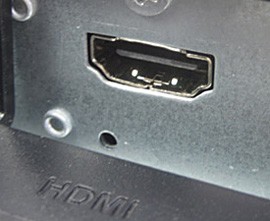
|
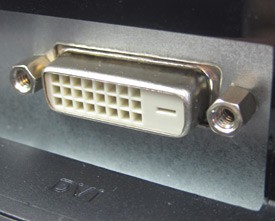
|
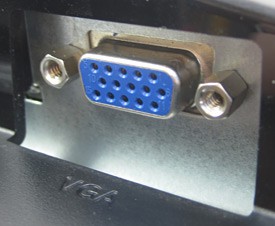
|
Q: Can I use a laptop as a display and/or keyboard?
A: The short answer is "not easily." Many newer laptops have HDMI ports, but they only function as HDMI out, to send a video signal from the laptop to a television or projector. They do not work as HDMI in to display an external signal on the laptop's screen. The laptop's keyboard is only designed to work with the laptop itself, not as a standalone keyboard for an external device like the Raspberry Pi.
The longer answer is that, similar to the Remote Desktop feature on Windows and Mac computers, you can use special software to remotely operate a Raspberry Pi that is connected to the internet. This would allow you to control a Raspberry Pi using your laptop's screen and keyboard. This option is only recommended for advanced users, and you can find instructions at Raspberry Pi Documentation.
Q: How do I connect my Raspberry Pi to the internet?
A: Unlike earlier models, the Raspberry Pi 3B+ contains built-in Wi-Fi functionality. It does not require an external USB Wi-Fi adapter. You can connect your Raspberry Pi to the internet by clicking the internet icon in the taskbar and searching for available Wi-Fi networks, just like you would on a Windows or Mac computer. Your Raspberry Pi also has an ethernet port, which you can use to plug directly into a router for a hardwired connection.
Q: How do I shut down or reboot my Raspberry Pi? There's no power button!
A: Unlike most computers, the Raspberry Pi does not have a power button. You can shut down or reboot by clicking the raspberry icon in the upper left corner of your desktop, then select Shutdown. After the Raspberry Pi has shut down, it is safe to unplug the micro-USB power cable. Plug the cable back in to reboot. Important: never unplug the power cable while the Raspberry Pi is still running. This can corrupt the SD card.
Q: How can I adjust the Raspberry Pi's display resolution?
A: Click the Raspberry Pi logo in the top-left corner of your desktop. Select Preferences, then Raspberry Pi Configuration, then click the Set Resolution... button on the System tab.
Q: I have everything connected properly. Why can't I hear any sound?
A: Right-click the speaker icon on the desktop taskbar. This allows you to manually select HDMI or analog (the headphone jack) for sound output. Make sure you have the proper output selected. Also, make sure your Scratch program is set to play a sound. You can write a simple program to test if your sound is working using the "when space key pressed" and "play sound meow" blocks.
Q: Why won't my Raspberry Pi turn on?
A: If your Raspberry Pi will not turn on (the screen remains blank after everything is plugged in), go through this checklist to make sure everything is set up properly.
- Make sure your SD card is pushed in all the way (see Figure 1).
- Make sure the red power LED on your Raspberry Pi (labeled "PWR," near the micro-USB port, see Figure 2) is on. This means the Raspberry Pi is receiving power from the micro-USB port. If the LED is not on, make sure you pushed the micro-USB connector into the micro-USB port all the way.
- When you first plug the micro-USB cable in, the green LED (labeled "ACT," next to the PWR LED, see Figure 2) should flash several times. This LED flashes when the Raspberry Pi reads data from the SD card. After the Raspberry Pi is done booting up, it should turn off. If it does not flash at all, your SD card might not be inserted properly. Go back to step 1.
- Make sure your display (television or monitor) is turned on. If your display is turned off, you will not see anything on the screen, even if the Raspberry Pi is on.
- Make sure your display is set to the correct input. Many modern TVs have more than one HDMI input, and some computer monitors have DVI or VGA inputs in addition to HDMI.
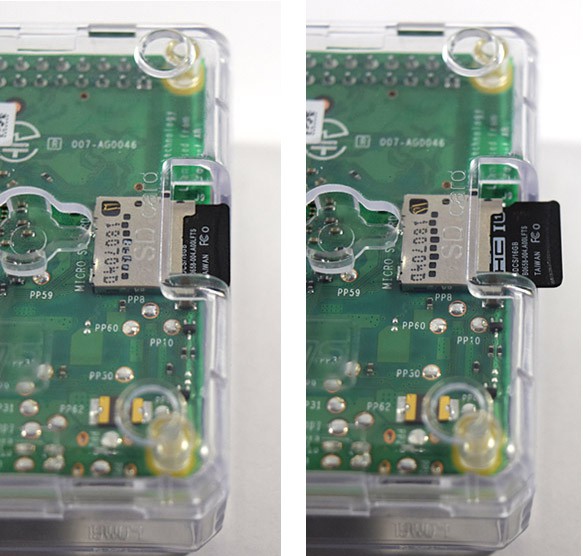
Figure 1. A micro-SD card that is inserted properly (left) and one that is not pushed in all the way (right).
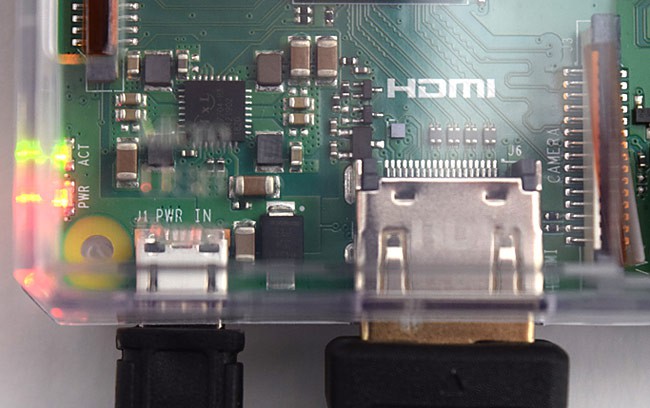
Figure 2. The PWR (red) and ACT (green) LEDs near the micro-USB port.
Q: My Raspberry Pi starts to boot up, but then it freezes or the screen goes blank. What is wrong?
A There may be a problem with your Raspberry Pi or SD card. If you are using the Raspberry Pi or SD card that came with the Raspberry Pi Projects Kit or Raspberry Pi Circuit Parts Only Kit purchased from our partner Home Science Tools, please contact them directly at service@homesciencetools.com for assistance.
Q: My Raspberry Pi froze and is not responding to mouse or keyboard input. What should I do?
A: First, be patient and give the Raspberry Pi a few minutes to try and process whatever it was doing. If you click on a whole bunch of things in rapid succession, or run a really complicated Scratch program, the Raspberry Pi might slow down or freeze temporarily.
Next, if you are using a wireless keyboard and mouse, make sure they have fresh batteries.
Finally, as a last resort, if your Raspberry Pi is not responding, unplug the micro-USB cable and plug it back in. In general, you want to avoid doing this, because suddenly cutting power to the Raspberry Pi without properly shutting it down first can corrupt the SD card, and prevent the Raspberry Pi from working properly.
Q: My Raspberry Pi is acting strangely (e.g. it suddenly will not boot up properly, certain programs do not work, etc.). What is wrong?
A: If your Raspberry Pi is not "dead," but seems to be behaving strangely, there is a chance that your SD card has become corrupted. This can happen if you unplug the Raspberry Pi's power cord without properly shutting it down first. See the next question.
Q: I think I corrupted my Raspberry Pi's SD card. What should I do?
A: If the SD card came with the Raspberry Pi Projects Kit or Raspberry Pi Circuit Parts Only Kit you purchased from our partner Home Science Tools, please contact them directly at service@homesciencetools.com for assistance. Make sure to include a detailed description of the problem you are having. They will work with you to resolve the issue.
Q: I need help with a question, related to my Science Buddies Raspberry Pi Projects Kit or Raspberry Pi Circuits Parts Only Kit, not listed here. Who can I ask?
A: Science Buddies has a special area of our Ask an Expert forums dedicated to the Raspberry Pi Projects Kit. Please note that the forums are staffed by volunteers, and it may take a few days to get a response. If you are doing a science project, please do not wait until the day before the project is due to ask an urgent question.



